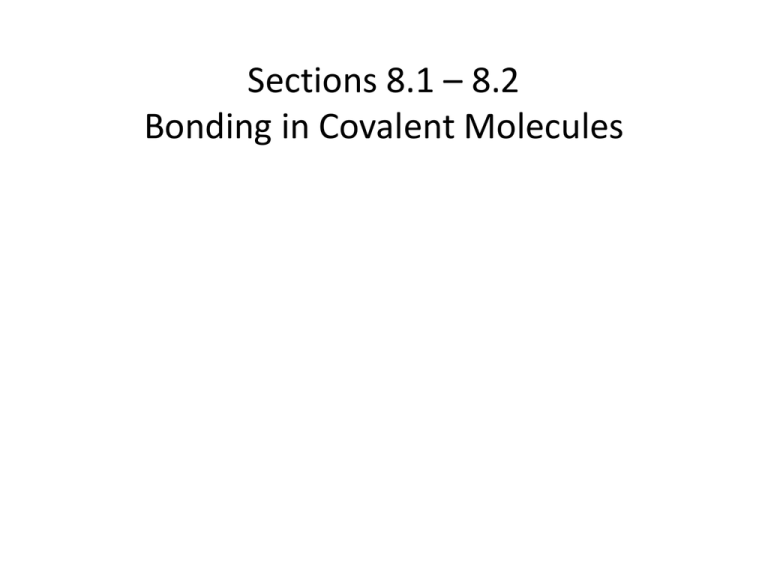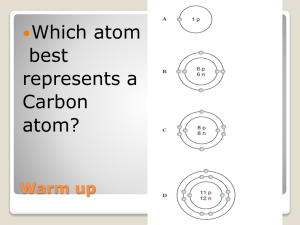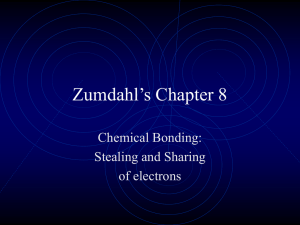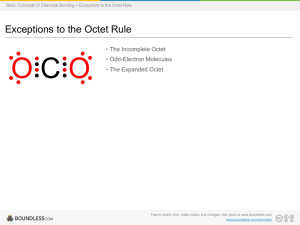Sections 8.1 * 8.2 Bonding in Covalent Molecules
advertisement

Sections 8.1 – 8.2 Bonding in Covalent Molecules Bonding in Covalent Molecules In these sections… a. Why do covalent bonds form? b. Valence Electrons c. Drawing Lewis Structures d. Exceptions to the Octet Rule e. Resonance Structures But first: This only works for… Coulomb’s Law: Electrostatic Attractions and Repulsions Force q A qB r 2 Why Do Bonds Form Between Neutral Atoms? H H Valence Orbitals and Electrons C F Lewis Symbols for Atoms C F Lewis Symbols for Atoms Lewis Symbols for Molecules Why Bother? How to Draw Lewis Structures: PF3 Step 1: Count valence electrons. Count the total number of valence electrons in the molecule or ion. Anions have extra electrons, so add 1 electron for each negative charge. Cations have a deficiency of electrons, so subtract 1 electron for each positive charge. Step 2: Arrange atoms. The central atom is usually the one with the lowest affinity for electrons (the one farthest from fluorine on the periodic table). Exception: H is never a central atom. Certain elements are found more frequently as central atoms (C, N, S, P) or terminal atoms (halogens, O) but there are, of course, exceptions. Electronegativity (Section 8.4b) can also be used to choose the central atom in a Lewis structure. How to Draw Lewis Structures: PF3 Step 3: Add single bonds. Add one bond (using a line) between each terminal atom and the central atom. Each bond represents 2 electrons. Step 4: Add remaining electrons. Assign any remaining electrons to the terminal atoms, in pairs, until the octet rule is satisfied for each terminal atom (except hydrogen). If additional electrons remain, add them to the central atom. Step 5: Check octet rule. Use the octet rule to determine whether multiple bonds are necessary between atoms. If there is an electron deficiency for an element, change a nonbonding electron pair (lone pair) on an adjacent atom into a bonding pair. Continue only until the octet rule is satisfied for all elements (other than the known exceptions described in Section 8.2c). Only C, N, O , P, and S form multiple bonds. How to Draw Lewis Structures: CO32Step 1: Count valence electrons. Count the total number of valence electrons in the molecule or ion. Anions have extra electrons, so add 1 electron for each negative charge. Cations have a deficiency of electrons, so subtract 1 electron for each positive charge. Step 2: Arrange atoms. The central atom is usually the one with the lowest affinity for electrons (the one farthest from fluorine on the periodic table). Exception: H is never a central atom. Certain elements are found more frequently as central atoms (C, N, S, P) or terminal atoms (halogens, O) but there are, of course, exceptions. Electronegativity (Section 8.4b) can also be used to choose the central atom in a Lewis structure. How to Draw Lewis Structures: CO32Step 3: Add single bonds. Add one bond (using a line) between each terminal atom and the central atom. Each bond represents 2 electrons. Step 4: Add remaining electrons. Assign any remaining electrons to the terminal atoms, in pairs, until the octet rule is satisfied for each terminal atom (except hydrogen). If additional electrons remain, add them to the central atom. Step 5: Check octet rule. Use the octet rule to determine whether multiple bonds are necessary between atoms. If there is an electron deficiency for an element, change a nonbonding electron pair (lone pair) on an adjacent atom into a bonding pair. Continue only until the octet rule is satisfied for all elements (other than the known exceptions described in Section 8.2c). Only C, N, O , P, and S form multiple bonds. Exceptions to the Octet Rule: Expanded Valence IF3 Step 1: Count valence electrons. Step 2: Arrange atoms. Step 3: Add single bonds. Step 4: Add remaining electrons. Step 5: Check octet rule. Only C, N, O , P, and S form multiple bonds. Exceptions to the Octet Rule: Expanded Valence When does this most often happen? Exceptions to the Octet Rule: Electron Deficient BF3 Step 1: Count valence electrons. Step 2: Arrange atoms. Step 3: Add single bonds. Step 4: Add remaining electrons. Step 5: Check octet rule. Only C, N, O , P, and S form multiple bonds. Exceptions to the Octet Rule: Electron Deficient Compounds When does this most often happen? Resonance Structures Equivalent Resonance Structures Nonequivalent Resonance Structures And remember: This only works for…









